#1.77???
Text
Hearing the McElroy brothers talk about how ~tall~ (5'10) Travis and Griffin apparently are only to find out that that's just 1.77 meters is hilarious.
#are you KIDDING me#1.77???#huh?#maybe 1.77 is taller than im thinking#but i literally laughed out loud when i converted the height to see how tall that is#justin made it sound like they were giants#like adonis statues#they're just#slightly above average wtf#justin i think you're just biased cause you're short man#mcelroys#mcelroy brothers#mbmbam#my brother my brother and me
40 notes
·
View notes
Photo

Basandra, Battle Seraph
"Why listen to the mumblings of wizards when the lash speaks true?"
Artist: Terese Nielsen
TCG Player Link
Scryfall Link
EDHREC Link
#mtg#magic the gathering#tcg#$1.77#terese nielsen#basandra battle seraph#commander anthology#legendary#creature#angel
69 notes
·
View notes
Text
YALL LOOK WHAT THEY HAVE AT WALMART!(They also have Freddy but I like Jason and Pennywise more)

#ALSO THERE ONLY $1.77 ????#LIKE WHAT THESE ARE AMAZING#horror#horror characters#pennywise#jason voorhees#Halloween
10 notes
·
View notes
Text
just learned two pieces of informations that are both not something i expected at all but at the same time make sense but lordd
#lyx is 1.77 and he gives at least 1.90 vibe. cfy is '00 line ??? im screeching quietly once like a mouse#00
9 notes
·
View notes
Text



Han Joo Won wants you to think he's this big intimidating figure. super tall and impressive. filling up a room with his presence... and he is... but he is also-
a silly smol bby



#beyond evil#han joo won#han juwon#ep 4 hjw#and yet thanks to yjg's acting and some nice camera work#hjw feels like the biggest guy in the room#also... hjw walks weird and we don't talk about it enough#tiffanylamps mocks han joo won#yjg is 5'8 / 1.77 m#nys is 6'1 / 1.86m#(tiffanylamps is an ancient giant from faraway lands who considers 5'8 to be kind of short bc she herself is taller than that -)#( but she is aware that 5'8 is still considered tall for some)#(scheduled)
61 notes
·
View notes
Text
i’m the same height as enea so that’s how i would look next to fabio 😭
#he is not that tall 1.77 it’s average i guess but let’s me wear my heels when i go to a race 🤣#meli talks shit#fabio
4 notes
·
View notes
Text

We’re back in front of the favorite 😏😏😏
1 note
·
View note
Text
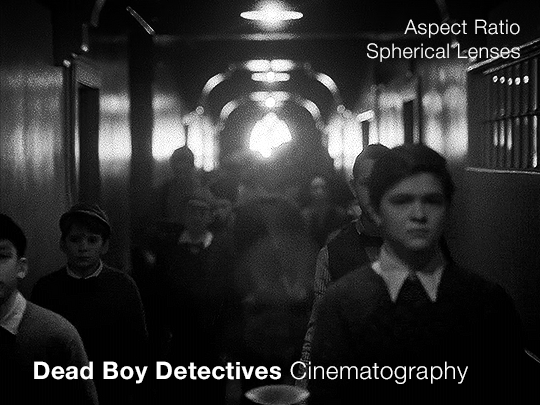
Part 2 — this time with a focus on the flashbacks
(Check out the first post for some background info that will be useful)
When we’re looking at the cinematography of any piece, once we’ve established what the norm is (which is the use of anamorphic lenses, as per the last post) we can then look to see where it diverges. As far as I can tell, the only part of Dead Boy Detectives that doesn’t use an anamorphic lens is Edwin’s flashback scene.
Now this is particularly interesting since not only is it filmed with a spherical lens, but it also is the only scene with a different aspect ratio, and the only scene in black and white. Everything about this scene is glaringly different. The easy and obvious reason is that it sets this scene apart as something important to pay attention to, as well as emphasizing the difference in the time period. But I want to highlight how exactly it does this since it is quite clever.
It also raises the question: Why not film Charles’ flashback scenes differently?
Like last time, let’s start with a review of history and technical information.
What is an aspect ratio?
This is just the ratio of the width to height of the frame. 1:1 is a square, whereas 2:1 is a rectangle twice as wide as it is high. In film, aspect ratios are usually listed as a ratio of x:1, so you get common formats like 1.85:1 and 2.39:1 (the second being a super-widescreen format, i.e. a long rectangle). Other common ratios are listed with different numbers, like 4:3 and 16:9. Any time I write an aspect ratio with other numbers, I’ll also list it at least once with the x:1 format so you can compare things easily.
What are some common aspect ratios and what have the standards been across the past 100+ years of film and television history?
Brief history of aspect ratios in Film
The original silent films were mostly filmed in 4:3 (1.33:1). This aspect ratio persisted until the late 20s/early 30s when the Academy Ratio, 1.375:1, was introduced and somewhat standardized (at least in the USA) until the 50s. Then, widescreen became pretty popular and was used to draw audiences to the theaters. At this point, we get tons of variation in aspect ratios in films. But, for American theaters, common projections are 1.85:1 (which became super common) and 2.40:1 or 2.39:1, whereas in some European theaters, 1.66:1 is a more common ratio.
Some other common ratios deal particularly with 70mm film:
Standard 70mm film is usually 2.2:1. However, using anamorphic lenses will create a higher aspect ratio, and unless using a specific format common in the 50s and 60s (Todd-AO), this wasn’t often the aspect ratio that viewers would see. (The Sound of Music was shot with Todd-AO in 2.2:1, but until recently, most people only saw the general release in 35mm, which had a different aspect ratio)
IMAX, which is 1.43:1 (if IMAX is shot on film and not digital, it uses 70mm film)
Brief history of aspect ratios in Television
Pretty much all televisions until around the 1990s-2000s used 4:3, and broadcasters would show content in that aspect ratio. If a movie was broadcast over TV, sometimes there would be letterboxing (black bars), but pan-and-scan was common, where they would crop the movie to the 4:3 ratio, and pan around to wherever the action was happening. Starting in the 90s, widescreen televisions started to gain traction, and the 16:9 (1.77:1) format prevailed, and TV broadcasting had some more wiggle room for aspect ratio.
**Side note: Computers are often at this ratio, so if you watch older TV shows on your laptop, you’ll probably see pillarboxing (black columns on the sides), whereas newer movies are often shot with higher aspect ratios so they have letterboxing (black bars on the top and bottom)**
A note on widescreen
Movies are usually considered widescreen if they’re any higher than 4:3 (or 1.33:1). However, because of the aspect ratio of modern TVs and computers, and the even higher aspect ratios of most smartphones in landscape mode, a lot of people (especially younger generations) won’t consider things “widescreen” until they’ve got a much higher aspect ratio.
Streaming and Aspect Ratios
A weird effect of streaming services, and in particular Netflix, was the rise of a new standard in aspect ratios, 2:1. It’s used in shows like Stranger Things. It’s widescreen enough that it feels cinematic but it displays well on lots of devices. There’s minimal letterboxing (or none) on your phone, and more letterboxing on your computer and TV, but not enough to seem like you’re watching a movie instead of a show.
Netflix (and Amazon) really like this aspect ratio. In 2017, one of the production requirement documents from Netflix stated that any aspect ratio greater than 2:1 had to be subject to further approval (though now they state “Aspect ratio choices should be discussed with Netflix for approval”). It’s become increasingly common, and these companies have a pretty set standard for 1.9:1 and 2:1. If we see those ratios on a streaming show it isn’t always a creative choice, similar to the way older TV shows were required to be in 4:3.
A brief reminder about lens types with some extra bits about the timeline.
That 2.39:1 aspect ratio that movies use? That’s the standard for anamorphic lenses (discussed in Part 1). Anamorphic technology was developed around 1915 (for military reasons), but wasn’t used for films until 1927, and didn’t become commonly used until the 50s.
So, with that, let’s look at Dead Boy Detectives.
Aspect Ratio
The whole show is shot with anamorphic lenses, but instead of a 2.39:1 ratio, they use a 2.2:1 ratio. This is a really interesting choice since it is an uncommon ratio. It’s more widescreen than Netflix shows (they started shooting before being acquired by Netflix though so we can ignore any impact Netflix may have had on this decision) but not quite the widescreen that anamorphic lenses typically use.
Movies and shows can use almost any aspect ratio today, but it is still common to stick to the standards. When they choose something else, it’s not because of technical limitations, but because of a creative choice.
The one caveat I have is that Doom Patrol used 2.2:1, so it’s possible that HBO and DC originally just chose this for continuity between the two, before the show was shifted over to Netflix and the Sandman universe. But for this post, I’m going to assume that they were sort of starting from scratch when choosing the look.
If we consider what a 2.2:1 ratio has been used for, and what viewers have been “trained” to associate it with, we end up with Todd-AO 70mm prints and a few others from the 50s and 60s. It’s the kind of aspect ratio you don’t see often unless you’re lucky enough to live near a theater with a 70mm film projector. There are a few notable movies shot in this aspect ratio: Lawrence of Arabia and 2001: A Space Odyssey. Some more recent movies that used 2.2:1 include Dunkirk, Tomorrowland, Nope, and the non-IMAX parts of Oppenheimer. It’s also occasionally used in recent TV, but not a ton, and not with many popular shows.
This is an aspect ratio used by large-format, high-budget movies. As mentioned in the previous post, anamorphic lenses are associated with a romanticized notion of “cinema” and this aspect ratio only serves to further that, associating Dead Boy Detectives with the limited pool of content made in this aspect ratio. It may be a TV show, but it’s being shot like a movie.
Another really interesting point that follows up on the previous post is the idea of using cinematography to enhance the sense of the supernatural and separate the characters from the normalcy of the real world. The aspect ratio is a bit unnatural too, which serves to complement and augment this.
Let’s briefly look at what the show would look like in different aspect ratios. As a baseline, this is the 2.2:1 aspect ratio that the show is in:

If they had gone for a 2.39:1, a very typical aspect ratio for the kind of lenses they’re using, it would look like this:
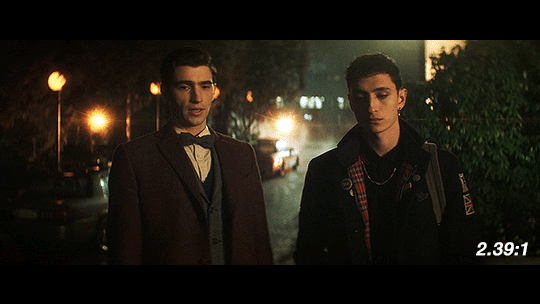
When we see things shot with anamorphic lenses, we’re used to seeing it in a frame like this one. Especially in shots like this with the dramatic lens flares, this is going to look and feel familiar to people who watch a lot of movies. It has more of that Star Trek (2009) look, and feels kind of glossy and polished.
Next up, we have 2:1, the aspect ratio popularized by Netflix. It’s a reasonable possibility that if this show had been produced by Netflix from the very beginning, this is what it would look like.

Over the past few years, this has become the “streaming platform” aspect ratio. With the extra vertical height, it’s got some extra space to breathe. We would get less of the background and more of the characters, especially since Dead Boy Detectives favors centered shots of single characters over group shots like this one.
Finally, I’ve got the scene in 1.85:1, a ubiquitous film aspect ratio, yet one that is not used often on TV.
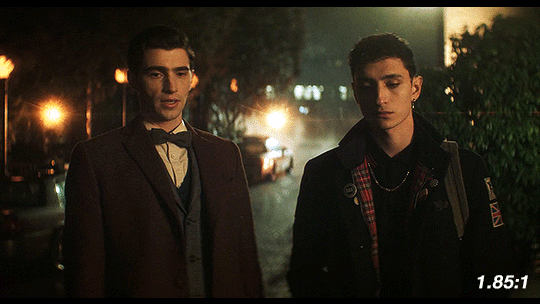
This is considered to be standard widescreen and it’s a great aspect ratio. Given how many creative decisions in this show were made to emphasize the supernatural, this could have been another good option as an aspect ratio, since we’re not used to seeing TV shows like this. However, they’re using anamorphic lenses so this would have required a lot of cropping. Because of how the anamorphic lenses work, this would also necessitate a lot of additional attention during the shoot. If they had gone with 1.85:1, we likely would have gotten a show shot on sphericals instead.
So what about Edwin’s flashback?
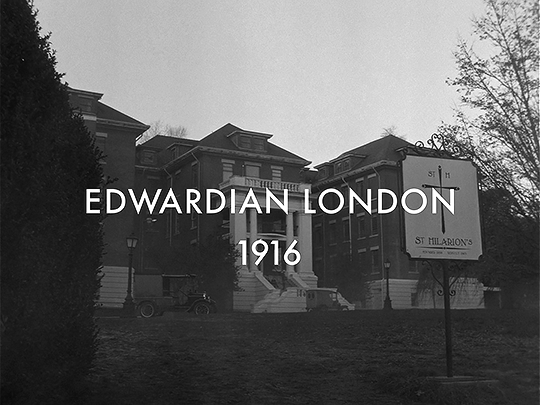
This section is shot in 4:3 (1.33:1). It’s the only part shot in a different aspect ratio. Sure, changing the aspect ratio forces us to acknowledge the difference in time period, but why exactly does it work so well?
Remember the history part? 4:3 was used for most of the early silent films. If we are to consider the “historical accuracy” of shooting the different time periods in this show, anamorphic lenses and 2.2:1 make sense for the present-day parts and Charles’ flashback.
But in 1916, widescreen cinema wasn’t a thing. If Edwin had ever been to see a movie while alive, it would have been in 4:3. The first time he would have ever gotten to see something in widescreen (if we assume he watches any movies at all) would be after he escaped Hell.
Using this aspect ratio is not just a vague decision that a lower aspect ratio and black & white looks older. It is, like many other aspects of the show, historically informed. They could have used the academy ratio here, but they didn’t. They used 4:3.
Not only does the aspect ratio switch for this scene, but also the height of the image changes.
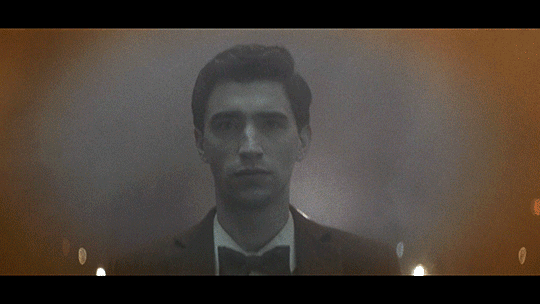
This transition also sort of mimics the breathing effect of anamorphic lenses:
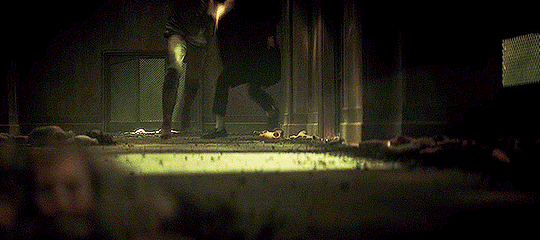
Something you may not know about how Netflix usually works is that regardless of the aspect ratio of the picture, the video file you see is part of a larger container, which is usually 16:9 (1.77:1). The black bars on top and bottom are part of the file, as shown in this screenshot of how it looks when you load up some screencaps in photoshop.
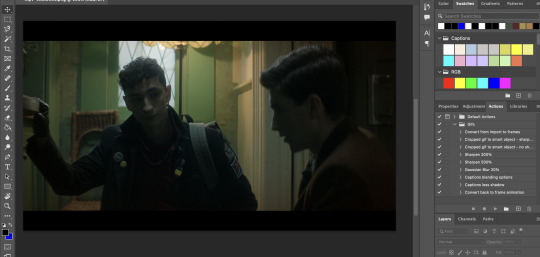
If you make gifs, edits, or are otherwise just used to having video files you are probably familiar with this. The Dead Boy Detectives files have letterboxing that is cropped out whenever people make fan content with it, whereas if you have a file for an independent movie, it usually does not have those black bars. Those black bars being part of the file make this transition possible.
We don’t usually realize that the container extends beyond the picture. For all we know, that’s the edge of the frame. But then it changes and forces us to reconsider what we previously thought to be true. Breaking out of what we think to be the image height is jarring, especially considering that this is the only time it happens (other than the brief flashbacks to the same footage later in the show).
Here’s a mockup of what it would look like if they kept the same image height, and just moved from 2.2:1 to 4:3 without expanding vertically. I find that it doesn’t have quite the same effect.

This would look so cool if it was being shown at a movie theater on a huge widescreen, but we’re not watching this show in theaters. We’re watching it on screens where this would make it look small; what they do instead retains the feel of watching something big and cinematic.
So back to the actual transition:

In breaking out of the perceived container, it’s as if it were breaking the fourth wall, an acknowledgment of the video’s format and its true container. This story is addressed to the audience in a way that the rest of the show is not, and it uses the aspect ratio to let us know that.
Spherical Lens
(I would highly recommend you read pt 1 if you haven’t already)
Edwin’s flashback is not only the sole scene with its own aspect ratio, it’s also the only scene shot with a spherical lens. Like the aspect ratio, this is a historically informed choice. Anamorphic lenses technically existed during the last year or two of Edwin’s life, but movies were not being shot on them.
How do we know that a spherical lens is being used, and how does this affect the show?
One of the quickest ways to identify the lens is to look at the shapes of the bokeh. There’s not much bokeh in the flashback, so I apologize for the intensity of my first example. But here, look behind Edwin’s head, where the lights from above reflect on the wet basement floor. They’re all circles, instead of the ovals that we get with the anamorphics.
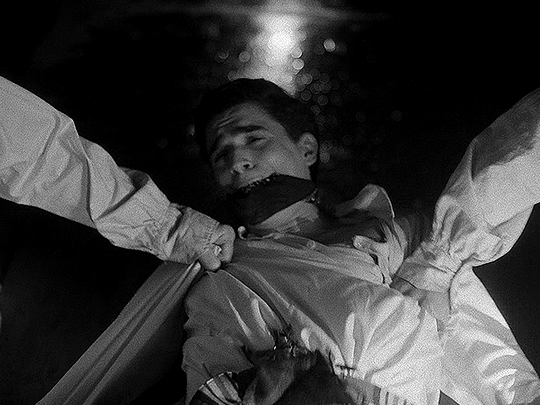
The lens flares are also really different. Remember that the anamorphic lens flares are horizontal lines. Spherical lenses don’t do that, but they can produce lots of different kinds of lens flares. In this shot, the flashlight pointed at the lens lets off lines in lots of directions, kind of like sun rays.
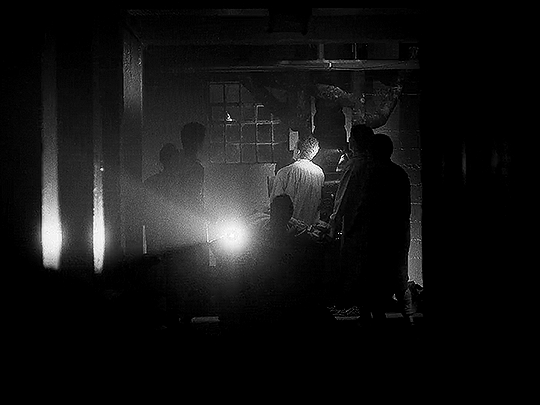
This shot has another cool flare, in much more detail this time:
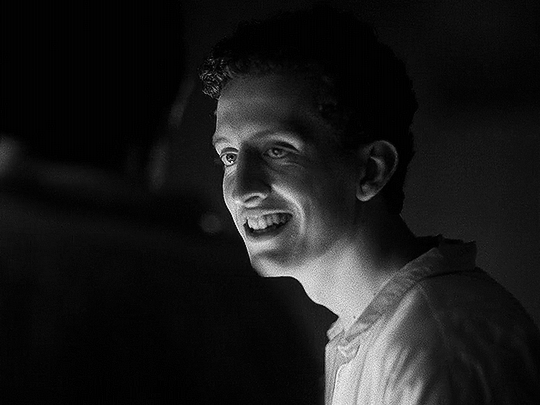
The next shot shows us more of the circular bokeh and another kind of lens flare.
For the bokeh, look at the lights on the ceiling as well as the corners of the out-of-focus architectural details (the semi-arches).
The lens flare here is the bouncing, blurry circle near the middle, as well as the brighter shape near the center bottom.
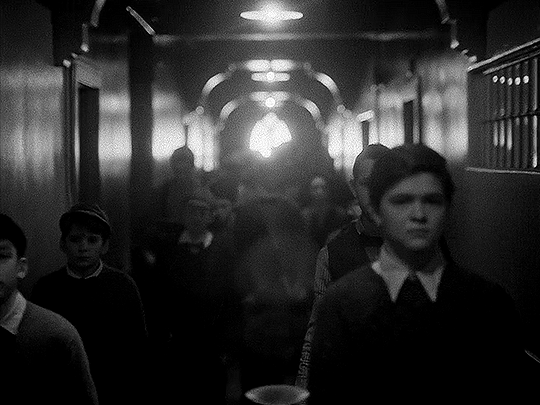
We can then look at the things that are not different, but absent when using the spherical lens: barrel distortion and focus falloff.
In this example, look at the windows in the background, as well as Edwin’s chair. An anamorphic lens would distort the vertical lines, bending them into a gentle fisheye. It would also make that chair and the lines of the window frames a bit blurry, as they’re close to the edges of the frame. Instead, the lines are straight and clear throughout the whole shot.
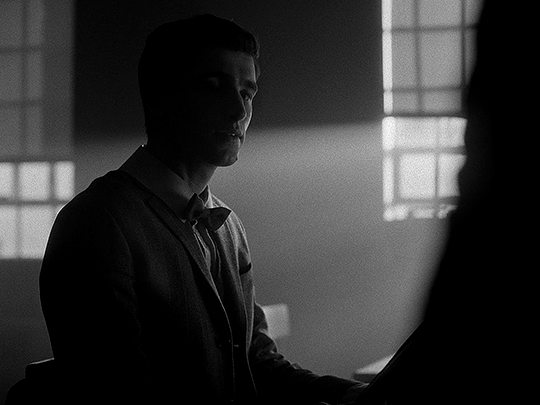
In this next example, not only do we get a great view of the lack of focus falloff, with clear lines throughout the shot, but we can see more of the difference in perspective and distortion of lines.
You may notice that the windows and doors are not perfectly straight up and down. But is this barrel distortion? If there was barrel distortion, the walls would curve back towards the center of the frame at the top.
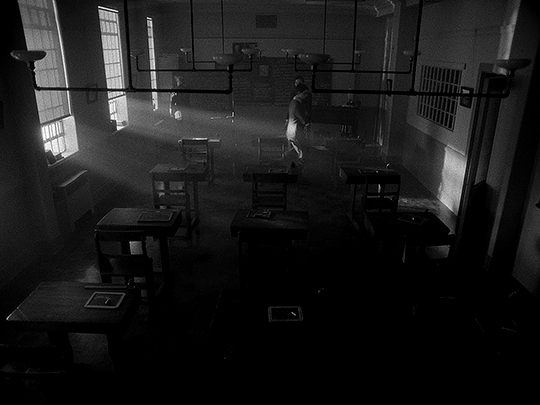
Spherical lenses are often the ‘default’ lens. They’re wonderful and used in a lot of media because they are neutral. They distort less, thus representing the world closer to how it actually is. If we consider the anamorphic lenses in the rest of the show being used to enhance the sense of supernatural and story, changing to a spherical lens enhances the sharp reality. This is Edwin, alive.
The image breaks out of its perceived container, reaching out to the audience, and then changes the lens to be more ‘real.’ In these two changes, not only do we have a more historically accurate image, but it's as if the creators are issuing a warning to us. Maybe the demon isn’t real, but bullies are. Kids can be cruel. Classmates hurt their queer peers. This is not fantasy, and this is as true in 1916 as it is today.
Using a spherical lens in this instance, juxtaposed to the rest of the show, is a dramatic shift to make, as it alters just about everything in the image. In using a less distorted picture, for this, we are reminded of reality and life and the mundane.
On Charles’ Flashback (and an experiment)
Edwin’s flashback got the Cinematography Treatment™ but what about Charles’ flashback? It’s shot with the same aspect ratio and lens as the rest of the show. From the perspective of historical accuracy, this is fine. It’s a scene that could have been shot in 1989, cinematographically speaking. The reason I suspect that it wasn’t given any stand-out look is because, unlike Edwin’s flashback, Charles’ flashback scenes are closely tied to the present-day plot. They aren’t just scenes of Charles remembering things, they are a direct result of the Night Nurse’s “memory magic.”
Maybe changing something here would separate us too much from the plot. Both flashbacks (in episodes 4 and 7) are induced for a specific purpose related to other present-day characters. It wouldn’t make as much sense to have them be standalones.
However, if I were simultaneously the showrunner, screenwriter, and cinematographer, I would give Charles a standalone flashback scene. In that flashback scene, here’s how I would shoot it:
There would be a much deeper depth of field/smaller aperture than the rest of the show, so the background would be more in focus.
There would be harder, less-diffused lighting. This would also impact the coloring, and I’d maybe add some more saturated lights.
I’d try to make an argument to shoot that scene on film (and then argue to do Edwin’s on film too).
There would be a different aspect ratio; 2.2:1 isn’t out of the realm of possibility for the 80s, but it wasn’t common, and it wouldn’t have the kind of impact I’m searching for if it didn’t change.
There are three different aspect ratios I would choose between, and the lens would change depending on my pick.
I’ve made some mock-ups for how these would look, though I cannot adjust things like bokeh and depth of focus, and I can only do so much with the lighting.
2.39:1 with anamorphic lenses (specifically Panavision lenses) This is a super standard widescreen, with a popular lens from the time. We don’t have lens info for the rest of the show, but I think they’re using Panavision anamorphics anyway so the lens may not be a change. Big, blockbuster action movies from the 80s would often be shot in this (perhaps most relevantly, Ghostbusters), and it’s a style that kind of faded in popularity in the 90s and 2000s, so it can have more of a retro look, especially if shot on film. One downside to this would be the aspect ratio change would not be as dramatic.
Movies from the 80s shot with this combo: Raiders of the Lost Ark (and other Indiana Jones movies), Star Wars: Episode V - The Empire Strikes Back (as well as Episode 4, which came out in the 70s. Episode 6 used the same ratio and did use anamorphic lenses, but not Panavision), Ghostbusters
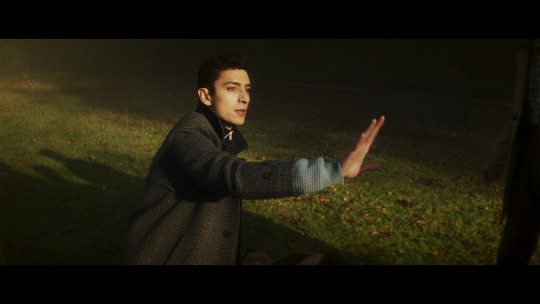
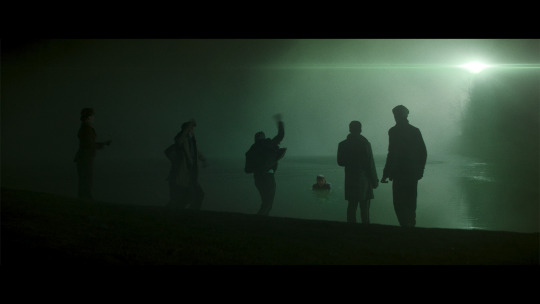
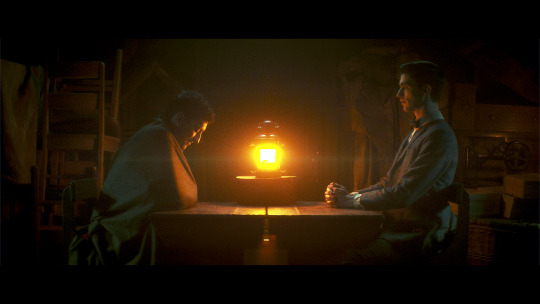

1.85:1 and spherical lenses. This is also ‘widescreen,’ but the advantage of using this aspect ratio is that we could get another dramatic breaking of the image container, just like in Edwin’s flashback. It’s an incredibly common setup, so it’s not really unique, but it would look different from the rest of the show. Given how pervasive ultra-widescreen still is today, I think a lower aspect ratio would also ramp up the ‘nostalgia’ factor a bit. Using a spherical lens we’d end up with the same sense of stark reality that we get for Edwin’s flashback as well (the warning that kids are cruel, but this time to people of color), and I like the idea of that as a parallel.
Movies from the 80s shot with this combo: Back to the Future, Dirty Dancing, The Princess Bride, An American Werewolf in London, Clue, Another Country

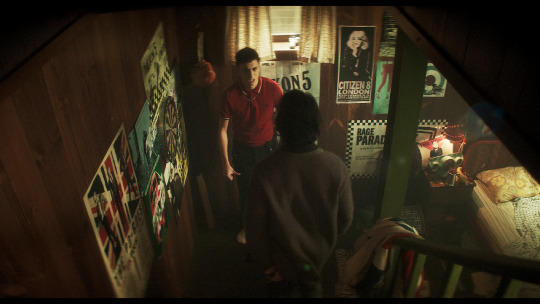
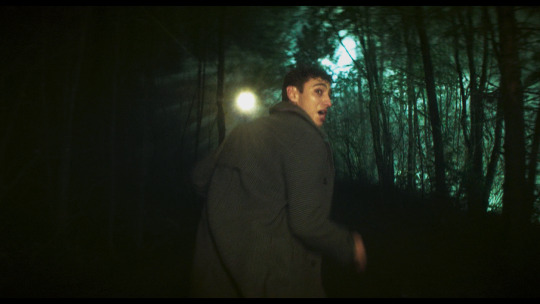

1.66:1 and spherical lenses. This is a ratio that was used widely across Europe, but has never been a common ratio in the USA. However, by the 80s, filmmakers were going for a more widescreen look so it was fading from popularity everywhere. The 80s liked widescreen, so it’s maybe not the best pick for making a scene look “80s”. However, my main motivation for this ratio is that my personal picks for the most Edwin-coded and most Charles-coded queer films are both 80s films shot with a 1.66:1 ratio. We would also get the same benefits from using the spherical lens as I mentioned in the 1.85:1 section.
Movies from the 80s shot with this combo: Maurice, My Beautiful Laundrette, Law of Desire (La ley del deseo), and an honorable mention to Chungking Express, a 90s film that really exemplifies the kind of look I'm going for here

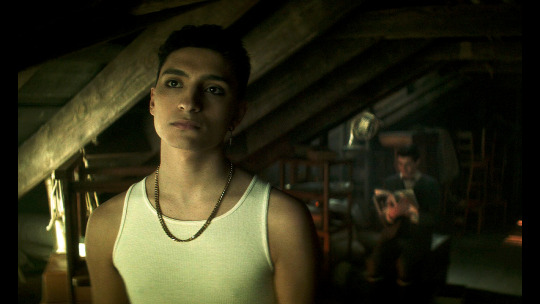
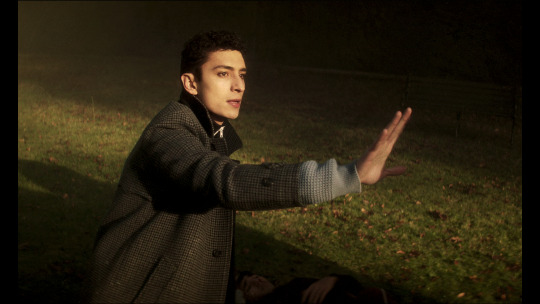
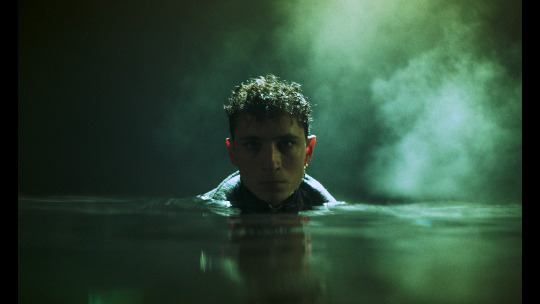
Giving Charles’ flashback a special treatment would probably do a lot to more firmly establish his character as a co-protagonist rather than a deuteragonist, which is definitely not the case but does seem to be how some people view him.
With the impact of the spherical lens and aspect ratio in Edwin’s flashback, the final two options for Charles flashback would be the closest in terms of echoing Edwin’s flashback, and would probably provide the most gravity and sense of crushing reality to the scene.
Setting a single scene (or two scenes) aside like this, with a unique aspect ratio, lens, and color grading (which I didn’t explore much for the Charles flashback), makes us consider a scene more independently from the rest of the show. Edwin’s flashback is a striking moment with a very different look, and that’s deeply memorable. It comes together to push how tragic and unjust Edwin’s story is.
—————
This concludes the planned portion of my cinematography analysis. I had a ton of fun researching and writing this (and making all the graphics) and I hope you all find this interesting/helpful/informative :)
Finally, I want to give another name drop to the cinematographers, Marc Laliberté, Craig Powell, and Pierre Gill. They’ve really nailed it from the very first episode to the last, and there’s so much intention and thought given to every aspect of how they shoot this.
#dead boy detectives#dbda meta#dbda#edwin payne#charles rowland#cinematography#dead boy detectives analysis#cinematography analysis#mygifs#dbdagifs
223 notes
·
View notes
Text



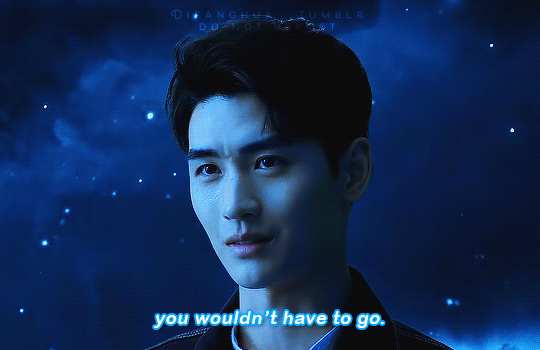

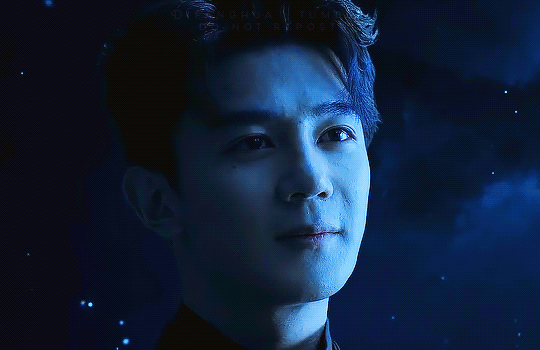
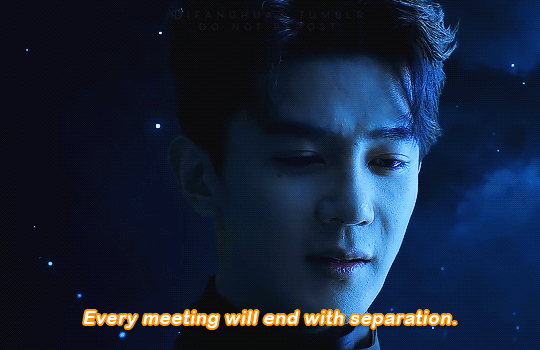


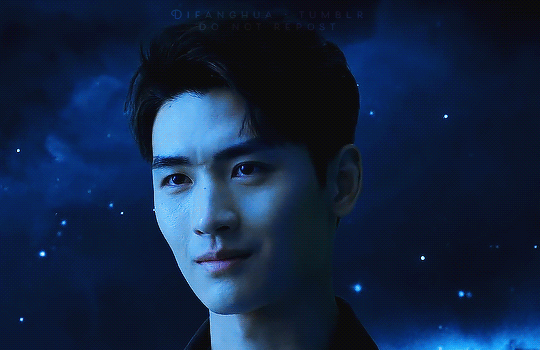
我这不想着,话没说完,你就不用走了吗。但这话,总有说完的时候嘛。
THE SPIREALM 致命游戏 (2024) 1.77
adapted from the danmei novel Kaleidoscope of Death 死亡万花筒 by Xi Zi Xu 西子绪
#userdramas#asiandramanet#cdramaedit#cdramasource#致命游戏#死亡万花筒#the spirealm#thespirealmedit#kodedit#kaleidoscope of death#asianlgbtqdramas#danmeiedit#danmei#*gifs#xia zhiguang#huang junjie#userinahochi#userkimchi#tuserjade#seamayweed#whose fucking idea was it to take a page out of guardian#但这话总有说完的时候嘛 fucking end me#me: i love doomed star-crossed romance#also me: what the fuck i did not sign up for this shit
157 notes
·
View notes
Photo

Nashi, Moon Sage's Scion
Artist: Valera Lutfullina
TCG Player Link
Scryfall Link
EDHREC Link
#mtg#magic the gathering#tcg#$1.77#valera lutfullina#nashi moon sage's scion#kamigawa: neon dynasty#legendary#creature#rat#ninja
37 notes
·
View notes
Text
Jason Kenney

Physique: Husky Build
Height: 5' 10" (1.77 m)
Jason Thomas Kenney PC ECA (born May 30, 1968) is a former Canadian politician who served as the 18th premier of Alberta from 2019 until 2022, and the leader of the United Conservative Party (UCP) from 2017 until 2022. He also served as the member of the Legislative Assembly (MLA) for Calgary-Lougheed from 2017 until 2022. Kenney was the last leader of the Alberta Progressive Conservative Party (PC Party) before the party merged with the Wildrose Party to form the UCP. Prior to entering Alberta provincial politics, he served in various cabinet posts under Prime Minister Stephen Harper from 2006 to 2015.





Kenney studied philosophy at the University of San Francisco, but returned to Canada without completing his degree. In 1989, he was hired as the first executive director of the Alberta Taxpayers Association before becoming the president and chief executive officer of the Canadian Taxpayers Federation. Kenney was elected to the House of Commons in the 1997 federal election for the Reform Party. In 2000, he was re-elected as a Canadian Alliance candidate and then was re-elected five times as a candidate for the Conservative Party of Canada.





Handsome, nice full lips, husky with nice wide hips. And that brings me to that bangable ass of his that looks good in a pair of jeans. You should know by now, I have the biggest weakness for big, thick asses and this guy his one of the best. Problem is, he’s losing weight. Jason you can lose the weight, just don’t lose that butt. Because if I visit Canada one day, I want to take him out for a test ride. You know what mean. Fucking.


Lets see, Kenney is bilingual, speaking French and English. He has never been married and has no children. Wait a minute. A tough-talking Conservative who has never been married and apparently doesn’t like to be open about his personal life. I think I need to visit Canada. Now. Not to offer Kenney the DICK and video tape it for posterity. It’s to see the beautiful country of Canada of course. And if that other thing happens, all the better.

74 notes
·
View notes
Text
Moth of the Week
Salt Marsh Moth
Estigmene acrea
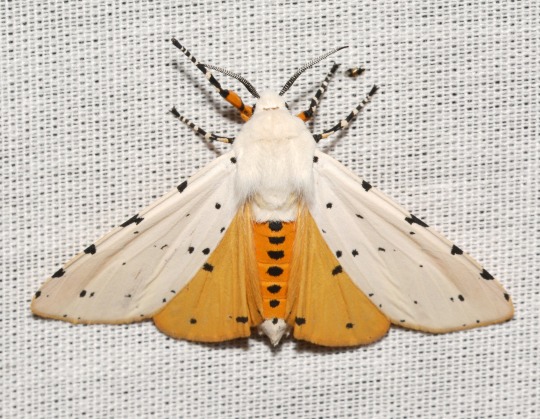
The salt marsh moth is a part of the family Erebidae. This species was first described in 1773 by Dru Drury. It is also known as the acrea moth.
Description Both male and female moths have white heads, thoraxes, and forewings with a varying pattern of black spots on the forewings, with some moths having no pattern at all. They also share an orange-yellow abdomen with a vertical line of back dots. On the male, the hindwings are the same organge yellow while on females the hindwings are white. Both males and females have three or four black dots on each hindwing.
Wingspan Range: 4.5 - 6.8 cm (≈1.77 - 2.68 in)
Diet and Habitat The caterpillar was first thought to be a pest to salt-grass, but in fact it prefers weeds, vegetables, and field crops such as dandelions, cabbage, cotton, walnuts, apple, tobacco, pea, potato, clovers, and maize. Adults do not feed.
This moth is found in North America, the Democratic Republic of the Congo, Kenya, Colombia, and Mexico. It prefers open habitats such as openings in woods, thickets, farm fields, grasslands, and marshes. It is called the “salt marsh moth” because it is common in coastal salt marshes (tidal marshes) along Pacific, Atlantic, and Gulf coasts.
Mating This species of moth does not emit pheromones from the tip of its abdomen but instead from its throat or the to of its abdomen. These moths are seen from May to August but can be seen all year in southern Florida and Texas. It is presumably during May and August they mate in most parts of their range while they mate all year round in Florida and Texas.
Yellowish eggs are laid in clusters on the host plant leaves. Females usually produce 400 to 1000 eggs in one or more clusters. It is possible to find a single egg cluster containing 1200 eggs. Eggs hatch in four to five days.
Predators This species is frequently parasitized as larvae, usually by flies in the Tachinidae family. In Arizona, the most common parasites were Exorista mellea and Leschenaultia adusta while two other parasitic flies were also seen: Gymnocarcelia ricinorum and Lespesia archippivora.
Both the larval and egg stages are oararzitized by Hymenopteran parasitoids such as Apanteles diacrisiae; Therion fuscipenne, T. morio, Casinaria genuina, Hyposoter rivalis; Psychophagus omnivorus, Tritneptis hemerocampae Vierick; Anastatus reduvii; and Trichogramma semifumatum.
A cytoplasmic polyhedrosis virus is known to harm this species but there are little data on its importance and effect.
General predators such as lady beetles, softwinged flower beetles, and assassin bugs prey on these caterpillars, but are not thought to have a large impact on population.
Fun Fact This species has 4 subspecies: Estigmene acrea acrea, Estigmene acrea arizonensis (Rothschild, (1910)) (Arizona), Estigmene acrea mexicana (Walker, (1865)) (Mexico), Estigmene acrea columbiana (Rothschild, (1910)) (Colombia).
(Source: Wikipedia, University of Florida, Missouri Department of Conservation)
#libraryofmoths#animals#bugs#facts#insects#moth#lepidoptera#mothoftheweek#Erebidae#salt marsh moth#Estigmene acrea
399 notes
·
View notes
Text
HAL 9000 STICKERS ARE REAL!!! EAT UP !!!



#2001 aso sticker#2001 a space odyssey#2001 a space odyssey fanart#hal 9000#hal 2001#HAL#2001 aso#stickers#etsy shop#digital art#robots
50 notes
·
View notes
Text
Volviendo a ver la pelicula de El Planeta de los Simios: Revolucion, me di cuenta en esta escena al final de la pelicula, que Cesar es igual de alto que Will (en este caso el actor James Franco el cual mide 1.80 cm segun google). Tal vez este unos centimetros mas abajo de Will, imagino 1.78 cm o 1.77 cm.
Lo digo por que siempre crei que Cesar era muchisimo mas bajito llegando tal vez al pecho de un hombre adulto jaja. Pero ahora veo que no y que realmente es alto.
O tal vez este equivocada o algo asi ajsjjsjs pero me gusta pensar que Cesar realmente es alto cuando esta parado en sus dos patas traseras. (🫦🫦🫦🫦🫦)


Por cierto, hize esto comparando la altura de Cesar con alguien que mideo 1.60, asi queeeee 🫦🫦🫦
Agrege otro pero con la altura de Andy Serkis, en caso de que Cesar mida eso ajajajsjaj


#POTA#planet of the apes#planet of the apes x reader#james franco#andy serkis#cesar my beloved#koba#Blue Eyes#El Paneta de los simios
32 notes
·
View notes
Text
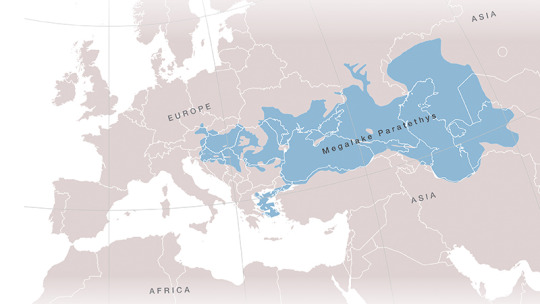
The rise and fall of the world's largest lake
The ancient Paratethys Sea once held more water than all of today’s lakes combined.
When continental plates smashed together about 12 million years ago, they didn't just raise new mountains in central Europe—they created the largest lake the world has ever known.
This vast body of water—the Paratethys Sea—came to host species found nowhere else, including the world's smallest whales. Two new studies reveal how the ancient body of water took shape and how surrounding changes helped give rise to elephants, giraffes, and other large mammals that wander the planet today.
To build that timeline, paleo-oceanographer Dan Palcu of the University of São Paulo and his colleagues at the main campus assembled clues from geological and fossil records. At its largest, the body of water—which some scientists consider to have been an inland sea—stretched from the eastern Alps into what is now Kazakhstan, covering more than 2.8 million square kilometers.
That's an area larger than today's Mediterranean Sea, they write this week in Scientific Reports. Their analyses further estimate the lake once contained more than 1.77 million cubic kilometers of water, more than 10 times the volume found in all of today's fresh- and saltwater lakes combined...
Read more: https://www.science.org/content/article/rise-and-fall-world-s-largest-lake
130 notes
·
View notes